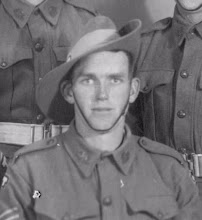Sunday, August 24, 2008
[Image] A rare wash at Tobruk
A rare chance to wash some clothes.
VX33235 Gunner J.W. Croft of the 2/3rd Light Anti-Aircraft Regiment has saved enough of his litre a day water ration to give some basic kit a wash. Gunner Croft hangs his washing to dry on a low slung washing line for a very good reason.
With the flat terrain at Tobruk, anything standing higher than three feet of the ground would draw artillery fire as being unnatural, and therefore enemy. For most men at Tobruk though, a wash in the ocean would be the closest they got to clean clothes.
One Digger recalled that for the entire duration of the siege he only once got a chance to wash, and that was a brief one hour trip to the beach. He also stated that he didn't brush his teeth for six months as it was a waste of precious water that could be drunk instead.
image p01260.012 Australian War Memorial.
Labels:
[1941],
[2/3rd Light AA Regiment],
[Tobruk],
[Water]
[Image] A Lucky Escape at Alamein
One Digger and a lucky escape.
This unidentified Digger of the 9th Division was wounded in both arms in the Second Battle of Alamein and captured by the Germans where he was transported, as a prisoner of war, to a German Dressing Station.
His wounds were treated by a German Medical Officer and when recovering the Dressing Station was captured by British Infantry where the Digger was released and returned to his Battalion. Here he is seen enjoying a smoke while catching up with excited mates.
image 042076 Australian War Memorial.
[Memorial] Australian War Memorial, Tobruk
16th October, 1941. Tobruk, Libya.
The unveiling of the Australian War Memorial.
This photograph was taken at the official ceremony to commemorate the unveiling of the tablet on the Australian War Memorial at the Tobruk War Cemetery. The memorial, built entirely by sappers of the Royal Australian Engineers, included a marble tablet inlaid at the base of the memorial.
The inscription reads;
"Here is hallowed ground, for here lie those that died for their country".
Major General Leslie Morshead officiated the official dedication of the war memorial to honour the Australian fallen of the Tobruk campaign. It would be some years before Maj. Gen. Morshead was to return to this site but return he did to honour his Rats of Tobruk.
image 020988 Australian War Memorial.
[Slang] Meet the Baitlayer
The baitlayer prepares his bait.
In another amusing example of Australian slang, the cooks of a battalion were referred to as "baitlayers". This derogatory term was a cheeky reference to the food being poisonous much like a bait for a wild animal.
In this picture the baitlayer is NX34516 Sapper Thomas M. O'Connor of the 2/4th Field Park Company, Royal Australian Engineers who has a reputation amongst the 9th Division as supposedly having 1001 recipies for bully beef. In this case he makes bully pancakes, which the men report as 99% pancake and 1% bully beef.
image 013357 Australian War Memorial.
[Image] The P.M. and the Private.
The Hon. Sir Winston Churchill.
The Prime Minister of England, Sir Winston Churchill, visits the 9th Division forward lines at Alamein. Dressed in Suit, Tie and with Pith Helmet, Mr Churchill uses a horsehair fly swatter to keep the insects at bay. He smokes one of his trademark cigars whilst he is escorted by Major General L.J. Morshead, GOC 9th Australian Division.
SX13319 Pvt. Stanley Collins
2/23rd Infantry Battalion.
When touring the front lines Mr Churchill stopped to speak with Pvt. Collins of Adelaide. What happened next ensured that Pvt. Collins was the most famous man in the 9th Division for a day. He bummed a cigar off the Prime Minister of England.

When later asked by curious mates if he intended to smoke it, Pvt. Collins joked that he was going to take it home have it sealed in glass and would then pass it down as a family heirloom. Pvt. Collins survived the war, discharging in September, 1946 as Staff Sergeant Collins. It is not currently known if he did indeed take the cigar home with him in early 1943.
images 024760, 013354 & 013355 Australian War Memorial.
Labels:
[1942],
[2/23rd],
[9th Div],
[Alamein],
[Anecdote],
[Humour],
[Morshead],
[Winston Churchill]
Subscribe to:
Comments (Atom)













